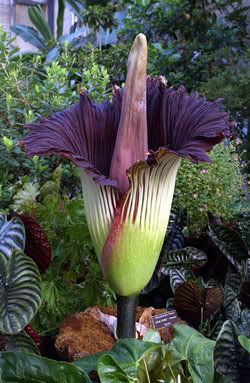Botanical pornography

One good thing about living in the central part of the Gahduhn State is that spring arrives earlier here than in Eastern Massachusetts, and certainly well ahead of south central Wisconsin. The young maple trees lining our street have a reddish glow, a color which subtly hints that the leaves which will emerge in a few short weeks. Larger buds can be seen on the flowering crabapple trees, and a few redbud trees are fully in the pink. Early narcissus are blooming and add cheery dashes of yellow and white among patches of last fall's dead leaves. However, long before the sap begins to run up the grey overwintered trees, the sure harbingers of spring in northern cllimes arrive during the coldest frozen days of January. Those are the seed and nursery catalogs.
I have poured over these catalogs ever since I began gardening in earnest some twenty-odd years ago. When I was a grad student, my spouse had a "real job" so we were fortunate enough to own a little house with a yard. I tended perennials along its borders and a variety of vegetables, including a mess of hot Thai peppers, in a sunny patch behind the old garage. My husband built what he called "the botany bench" underneath the basement stairs. He installed growlights above the pineboard bench, and with a heating wire beneath the seed starting mixture, I grew bright green seedlings while the bitter Wisconsin winter held fast in February and March with occasional snowy incursions into April. Wayside and Park Seeds were my catalogs of choice, and although Connecticut's White Flower Farms has recently found favor now that I live in the East, the other two are old friends.
Nursery catalogs are designed to seduce. The plants and flowers pictured are lush, lusty specimens, and no less alluring to the amateur horticulturalist than a Jenna Jameson spread is to a perpetually tumescent young man. The full shots of lilies, delphiniums, gallardia, and roses draw in the winter crazed gardener, and sucker him or her into believing that those glorious blossoms could really flourish in the garden. "Yes, yes, I can cultivate those Blackmore and Langdon delphiniums," I gurgled to myself when I, a young inexperienced gardener, gazed at these catalogs full of turgid floral beauties. While in the grasp of winter, these catalogs played on my desperation, and I imagined myself as a latter day Gertrude Jekyll.
The seduction by such botanical pornography shouldn't be surprising. After all, flowers are sexual parts, and are sometimes monoecious, sometimes dioecious depending on the species. Many plant species rely on insect vectors to assist with reproduction. Plants have co-evolved in a most marvelous way with their insect pollinators, and have devised clever ways of luring bugs to their flowers. Magnolia are among the most primitive of flowering trees, and they attract the more primitive insects, like beetles. The titan arum's most appropriate scientific name is Amorphophallus titanum (see photo). It is also dubbed the corpse flower due to its fetid perfume which attracts carrion beetles. The Rosaceae, a family of plants which arose after magnolias and which include plum and apple trees, call their sweet siren song to more complex insects like honey bees. Perhaps the one of the most striking co-evolutionary relationships between bug and bloom is that of the orchid with the wasp. The orchid's innards are shaped to look like the hind end of a female wasp, and the plant emits a phermonish molecule which reels the male wasp to its petals. The horny bug attempts to copulate with the orchid, and once finished, or frustrated, he flies away to another orchid and distributes pollen which is roughly the spermatazoan (sans flagella) equivalent of the flower, The sexuality of grasses evolved beyond mere insect pollinators and relies on mechanics like wind, rain or a passing critter's fur to transport pollen.
Humans recognize the sexuality of flowers. Blooms have long been a part of courtship ritual in the Western world. Robert Mapplethorpe and Georgia O'Keefe are among artists who exploited floral sexuality. Floraphiles themselves have predilections which are near fetishitic in their focus. Two friends are avid rosarians. In spite of highly different climates (one lives in upstate New York and the other in Southern California), these ladies are dedicated to roses, particularly the more rough and ready old fashioned varieties. In spite of my living in a spot which will not readily harbor a rose, they are ever after me to plant some rose, any rose, which I see as a testament to their obsessions. I did grow a nice climber, Zephirine Drouhin (see photo) in my little yard in Cambridge, MA, but most of my gardening here in Princeton is confined to containers. Here I make do with lush leafed caladiums and fragrant lilies (see photo). I know my friends really, really wish I would plant a rose, and are convinced that I will not be complete unless I do. As an experienced, and even somewhat jaded, gardener, I can resist the rose's call. It is time, however, for me to open the pages of the flower porn catalogs and order lily and caladium bulbs as I enter my own horticulturally hedonistic rites of spring.

1 Comments:
Dear Doc,
I love your page. And I have something I very much want to email you about, but I cannot seem to find an email contact for you anywhere in the Chimpanzee Refuge. Would you please drop me a line at the following: sharpe@seedmediagroup.com? Thank you so much...
Post a Comment
<< Home